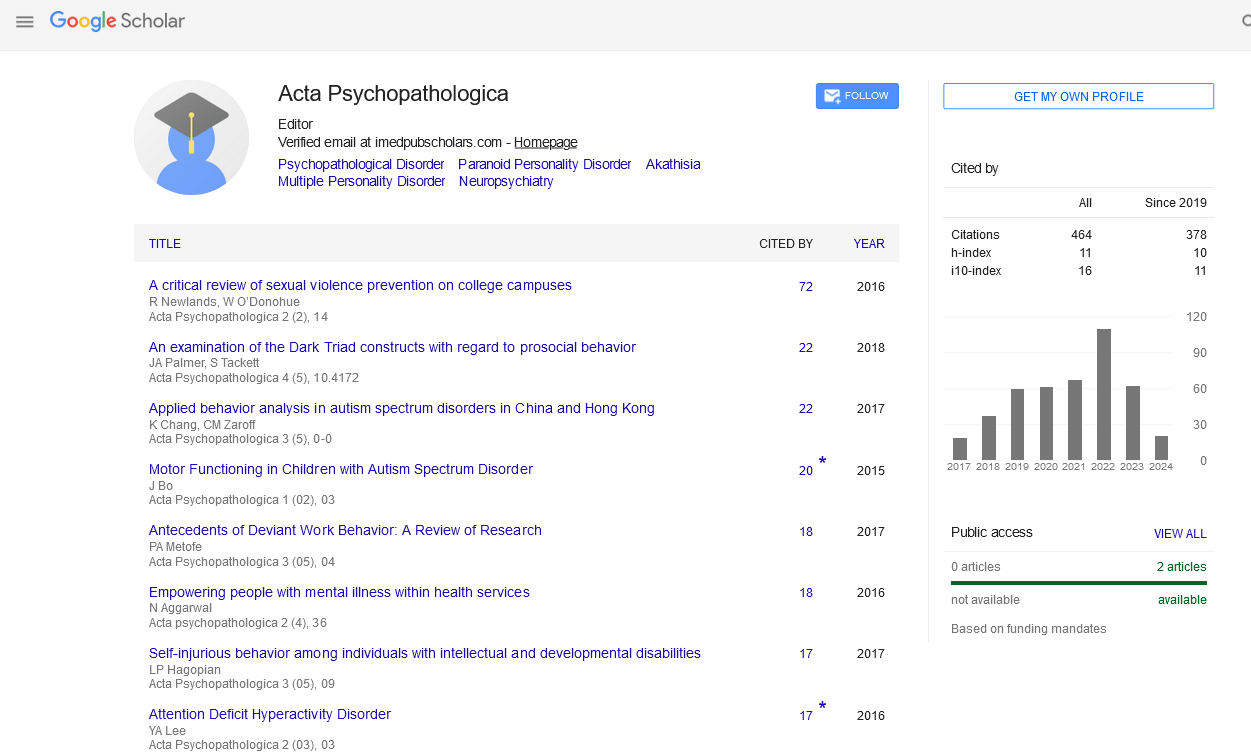Indexed In
- China National Knowledge Infrastructure (CNKI)
- CiteFactor
- Electronic Journals Library
- Directory of Research Journal Indexing (DRJI)
- OCLC- WorldCat
- Publons
- Geneva Foundation for Medical Education and Research
- Google Scholar
- SHERPA ROMEO
- Secret Search Engine Labs
- Serials Union Catalogue (SUNCAT)
Useful Links
Share This Page
Journal Flyer

Open Access Journals
- Agri and Aquaculture
- Biochemistry
- Bioinformatics & Systems Biology
- Business & Management
- Chemistry
- Clinical Sciences
- Engineering
- Food & Nutrition
- General Science
- Genetics & Molecular Biology
- Immunology & Microbiology
- Medical Sciences
- Neuroscience & Psychology
- Nursing & Health Care
- Pharmaceutical Sciences
Commentary - (2024) Volume 10, Issue 5
Gut-Brain Axis: Microbiome and Metabolome Alterations in Phobic Companion Dogs.
Hunter Milles*Received: 01-May-2024, Manuscript No. IPAP-24-20472; Editor assigned: 03-May-2024, Pre QC No. IPAP-24-20472 (PQ); Reviewed: 17-May-2024, QC No. IPAP-24-20472; Revised: 22-May-2024, Manuscript No. IPAP-24-20472 (R); Published: 29-May-2024, DOI: 10.36648/2469-6676-10.05.47
Description
Companion animals, especially dogs, have become integral parts of human households, providing emotional support, companionship, and numerous health benefits. However, like humans, dogs can suffer from various psychological disorders, including phobias. Phobias in dogs manifest as intense, irrational fears of specific stimuli or situations, often leading to significant distress and behavioral issues. Recently, researchers have begun to explore the potential biological underpinnings of these conditions, focusing on the gut microbiome and metabolome. This study aims to investigate the alterations in microbiome and metabolome profiles in companion dogs diagnosed with phobia, providing insights into the complex interactions between gut health and mental health in these animals. The gut microbiome, consisting of a vast array of microorganisms including bacteria, fungi, viruses, and their collective genetic material, plays a crucial role in overall health, influencing immune function, digestion, and even behavior. In humans, alterations in the gut microbiome have been linked to various psychological conditions, including anxiety, depression, and phobias. Similarly, the gut-brain axis, a bidirectional communication network between the gut and the brain, is being investigated in dogs to understand how changes in the gut microbiome might influence behavior and mental health. In this exploratory study, dogs diagnosed with phobia were compared to a control group of non-phobic dogs to identify any significant differences in their gut microbiome and metabolome profiles. Fecal samples were collected from both groups for microbiome analysis using 16S rRNA gene sequencing, which provides a detailed view of the bacterial composition within the gut. Additionally, metabolome profiling, which involves the comprehensive analysis of metabolites in biological samples, was conducted using advanced techniques like mass spectrometry. The findings revealed significant differences in the gut microbiome composition between phobic and nonphobic dogs. Phobic dogs exhibited reduced microbial diversity, a common indicator of dysbiosis, or microbial imbalance, which has been associated with various health issues. Specific bacterial genera, including Lactobacillus and Bifidobacterium, known for their beneficial effects on gut health, were found in lower abundance in phobic dogs. Conversely, an increase in potentially pathogenic bacteria, such as Clostridium and Enterobacter, was observed. These alterations suggest that phobic dogs have a disrupted gut microbiome, which may contribute to their psychological distress. Metabolome analysis further supported these findings, showing distinct differences in the metabolic profiles of phobic and non-phobic dogs. Phobic dogs exhibited altered levels of key metabolites involved in neurotransmitter pathways, including serotonin and gamma-aminobutyric acid (GABA), which play critical roles in regulating mood and anxiety. Lower levels of short-chain fatty acids (SCFAs), such as butyrate, acetate, and propionate, were also detected in phobic dogs. SCFAs, produced by the fermentation of dietary fibers by gut bacteria, are crucial for maintaining gut health and have anti-inflammatory properties. Their reduced levels in phobic dogs indicate a compromised gut environment, potentially influencing their mental health. The study also highlighted the potential impact of diet on the gut microbiome and metabolome. Dogs with phobia often had diets lower in fiber and higher in processed foods compared to their non-phobic counterparts. This dietary difference could contribute to the observed microbial and metabolic imbalances, suggesting that dietary interventions might be a viable strategy for managing phobia in dogs.
Acknowledgement
None.
Conflict Of Interest
The authors declare that they have no conflict of interest.
Citation: Milles H (2024) Gut-brain Axis: Microbiome and Metabolome Alterations in Phobic Companion Dogs. Act Psycho. 10:47.
Copyright: © 2024 Milles H. This is an open-access article distributed under the terms of the Creative Commons Attribution License, which permits unrestricted use, distribution, and reproduction in any medium, provided the original author and SOURCE are credited.

